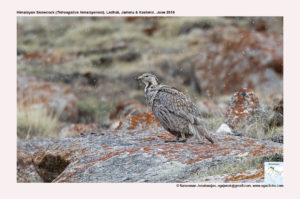
Himalayan Snowcock Tetraogallus himalayensis
Etymology:
- Tetraogallus : Latin word tetrao – game bird, probably the Black Grouse ; gallus- farmyard cock
- Himalayensis : From Himalayas
Vernacular Names: Persian: Kabk-i-dara, kowk-i-zarreen, Kash: Kabak, U.P.: Huinwal, Jermonal, H.P.: Leep, Galaond, Gleund, Gurakakov, Raamchakor, Nepal: Kulla, Lupu, Baera
Distribution in India: Resident of Himalayas in India.
Description: Size of 54–72 cm; Wt. of 2000–3629 g. It has a paler breast and with more horizontal blackish streaking. It is the only member of genus with a thin brown collar at base of white throat. It has a white throat and sides of the head are bordered by chestnut moustachial stripe and a dark broad chestnut band stretching from the eye over the ear, expanding into the collar. The upper parts are grey, with feathers of the rump and the wings are bordered with rufous. The upper breast is grey with dark crescent bars. The lower breast plumage is dark grey, and the sides of the body are streaked with black, chestnut and white. The undertail coverts are white. The Irides are brown, bill is brownish horn with darker maxilla, orbital skin is rose-red, and legs also red. Both the sexes are alike in plumage, but the female is smaller and lacks the large tarsal spur of the male. The male has single, short spur. The juvenile is paler, with less distinct markings, except white supercilium, with rufous-tipped crown and ear-coverts feathers, chestnut nuchal band and variable chevron-shaped buffy tips to underparts. It achieves adulthood in second winter, with first-year male much like dull female, but many have upperparts spotting larger and brighter. The races vary in general tone of plumage coloration: nominate is darkest and greyest, but becomes paler in far West of its range; race incognitus is paler and more buff-toned, with narrower chestnut neck markings, and weaker chestnut and black markings on underparts; race sewerzowi intergrades with incognitus in the Pamirs, but is even paler than the latter, and has more rufous and buff in plumage than nominate, with better-developed chestnut markings on neck, breast and flanks; race koslowi is also pale, although not as much as sewerzowi, with large cinnamon upperparts spotting and vinaceous-coloured underparts; race grombczewskii is overall the palest race.
Habitat: It is found in open mountain slopes from just below tree-line up to snowline. It is found between 2500 m and 6000 m. In winter it occurs in steep valleys and on mountain spurs and comes down to 2100–2400 m.
Food habits: It eats bulbous roots and tubers, berries, grasses, sedges, shoots and leaves. In winter takes variety of vegetable material from exposed slopes where snow does not persist, eating similar food to that consumed in summer. It moves uphill slowly during the day, foraging by raking the ground and digging with bill. It forms small flocks during non-breeding season.
Breeding habits: They breed in Apr to May. They are monogamous and territorial. The nests is in depression amongst grass tufts near rock or boulder, sparsely lined with grass, wool and downy feathers, usually near ridge top, cliff face or steep slope. They lay a clutch of 5–10 eggs. The incubation period is 30 days and done by female alone while the male acts as a guard. Both the adults raise young, but only female broods, and when pair feeding together, male remains more vigilant. Captive females can lay 120–150 eggs per year.